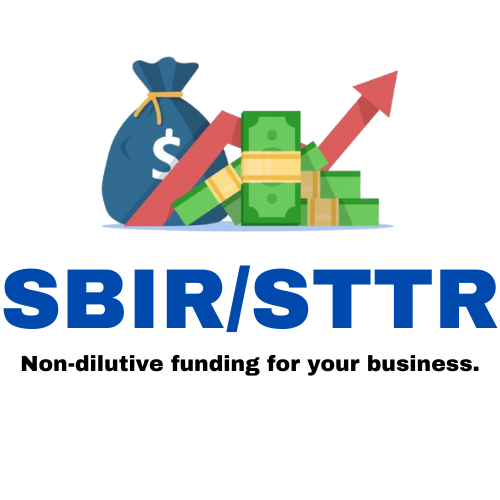COMING SOON!

Government Start-Up Funding? IT TRUE!
The SBIR (Small Business Innovation Research) and STTR (Small Business Technology Transfer) programs are federal initiatives designed to support small businesses engaged in innovative research and development (R&D) with the potential for commercialization. These programs provide non-dilutive funding, meaning businesses don’t have to give up ownership or equity in exchange for financial support, making them highly attractive to early-stage companies looking to scale their operations and bring new technologies to market.
What are SBIR and STTR?
Both programs are focused on driving innovation, but they differ slightly in their approach and requirements:
1. SBIR (Small Business Innovation Research) Program:
– The SBIR program provides funding directly to small businesses to develop new technologies, often with an emphasis on products that meet federal R&D needs.
– The goal is to encourage small businesses to explore their technological potential while ensuring that these innovations can be commercialized.
– No requirement for collaboration with a research institution, although businesses can choose to do so if it benefits their project.
2. STTR (Small Business Technology Transfer) Program:
– The STTR program requires small businesses to formally collaborate with a nonprofit research institution (such as a university or federal lab). This partnership aims to bridge the gap between academic research and practical commercialization.
– Mandatory collaboration with a research institution sets STTR apart from SBIR.
– The small business must perform at least 40% of the R&D, with the partnering research institution performing at least 30%.
Key Benefits of SBIR/STTR Programs
1. Non-Dilutive Funding:
One of the most significant advantages is that the funding provided through SBIR and STTR programs is non-dilutive. This means that small businesses receive financial support without having to give up any ownership or equity in their company. This is different from venture capital or other private investment options, which often require giving up a portion of the business in exchange for funding.
2. Access to Federal R&D Contracts:
Many federal agencies participate in these programs, such as the Department of Defense (DoD), National Institutes of Health (NIH), NASA, and the Department of Energy (DoE). These agencies need innovative solutions, and the SBIR/STTR programs help them source and fund R&D that addresses their needs, giving small businesses opportunities to secure lucrative contracts.
3. Support for High-Risk Innovations:
These programs are designed to fund high-risk, high-reward research. Many small businesses struggle to find private investment for these kinds of projects, but the SBIR/STTR programs are specifically focused on funding early-stage technologies that might not have a fully established market yet but show strong potential for success.
4. Commercialization Focus:
Unlike some academic research funding, SBIR/STTR grants are aimed at helping small businesses move from R&D to actual market products. They help bridge the gap between innovation and commercialization, ensuring that these technologies can make it to market.
Phases of SBIR/STTR
Both programs have three phases:
1. Phase I:
– This phase involves exploring the feasibility of the idea. Small businesses receive initial funding (up to $150,000 for SBIR, and similar amounts for STTR) for six months to one year to prove the concept’s viability.
2. Phase II:
– If Phase I is successful, businesses can apply for Phase II funding, which is much larger (up to $1 million over two years). This funding supports further R&D, product development, and prototype creation.
3. Phase III:
– In this phase, the goal is commercialization. No additional SBIR/STTR funds are provided, but businesses are expected to use private investment, revenue, or government contracts to bring their product to market. Government agencies may also contract with the small business to further develop the technology.
Who Should Consider SBIR/STTR Funding?
These programs are well-suited for:
– Small businesses with fewer than 500 employees engaged in technological innovation, particularly in sectors like defense, healthcare, energy, and advanced manufacturing.
– Startups and early-stage companies that have strong technical ideas but need capital to conduct R&D.
– Companies focused on high-risk, high-reward technologies where private investment might be harder to obtain.
– Small businesses in partnership with research institutions, especially in fields like biotechnology, nanotechnology, aerospace, and IT.
– Businesses that are committed to moving from the research phase to the **commercialization phase and can demonstrate a path to market.
Key Differences Between SBIR and STTR
1. Collaboration Requirement:
– SBIR: Small businesses can work independently or collaborate with research institutions, but collaboration is not mandatory.
– STTR: Formal collaboration with a nonprofit research institution is required, with a clear division of work between the small business and the institution.
2. Funding Amounts and Focus:
– While the structure and phase system are similar, the **STTR** program’s primary goal is to foster innovation through the transfer of technology from the research institution to the marketplace, while **SBIR** focuses more broadly on small business innovation across all sectors.
3. Eligibility:
– SBIR: The business can be the sole entity performing the research and development.
– STTR: At least 30% of the R&D must be performed by a nonprofit research institution, and the business must perform at least 40%.
The SBIR and STTR programs offer significant benefits for small businesses, particularly those working on cutting-edge technologies with high commercial potential. The non-dilutive funding structure makes them an ideal source of capital for early-stage companies, allowing entrepreneurs to retain ownership while developing and commercializing their innovations. Businesses in fields like biotechnology, defense, healthcare, and energy that have partnerships with research institutions or conduct their own R&D should seriously consider pursuing these opportunities. The structured phases also provide a clear pathway from concept to market, ensuring that companies have the resources needed to scale and succeed.
Is there a particular industry or innovation you’re considering that might benefit from this type of funding? I’d be happy to discuss how these programs could apply!
